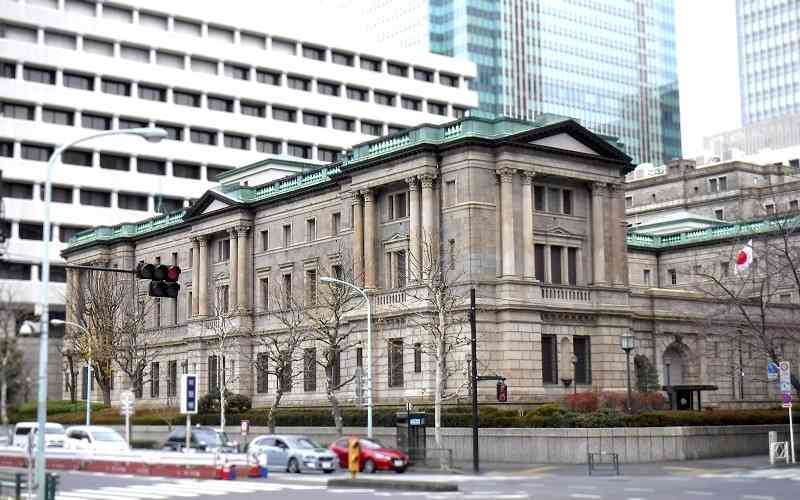
The Bank of Japan building
11:04 JST, December 17, 2022
TOKYO (Jiji Press) — The Bank of Japan’s latest Tankan quarterly business sentiment survey suggests that higher materials prices reflecting factors such as Russia’s invasion of Ukraine continue to weigh on major Japanese manufacturers.
Some large manufacturers have been unable to offset rising materials costs with hikes in their product prices, while large nonmanufacturers are cautious about their business conditions going forward although their sentiment showed a continued improvement in the closely watched central bank survey.
Rising materials prices are serving as an impediment to corporate Japan’s full-fledged earnings recovery from the slump blamed on the COVID-19 pandemic.
In the Tankan survey for December, which was released Wednesday, the headline diffusion index for large manufacturers’ current business conditions stood at plus 7, down 1 point from the previous September survey, falling for the fourth straight quarter. The DI for large nonmanufacturers rose 5 points to plus 19, up for three quarters in a row.
The DI represents the percentage of companies seeing favorable business conditions minus that of firms feeling the opposite.
“We couldn’t make up for higher materials costs with benefits from a weaker yen,” Suzuki Motor Corp. President Toshihiro Suzuki said of the automaker’s recent business performance.
The situation is believed to have been the same for many other manufacturers. The yen’s precipitous decline this year was supposed to be a plus for exporters, including automakers, for which long-lasting supply constraints for semiconductors and other items have finally subsided. However, rises in procurement costs served as a headwind throughout the year.
In the December BOJ survey, the input price DI for large manufacturers, or the proportion of companies with higher procurement costs minus that of firms seeing lower costs, came to plus 66, the highest since May 1980.
“The pace of rise [in materials prices] has been unprecedented,” Kazunari Kumakura, chief officer of Toyota Motor Corp.’s Purchasing Group, said. “The business environment [surrounding our company] is severe,” he added.
The output price DI, or the percentage of firms with higher sales prices minus that of companies with lower prices, hit record highs for both large manufacturers and large nonmanufacturers, at plus 41 and plus 28, respectively, suggesting that moves to pass on higher costs to customers are spreading among major companies in Japan.
Still, many companies are struggling. “Not all of the higher costs can be covered [with price hikes],” a Mitsubishi Electric Corp. official said.
Sanitary ware maker Toto Ltd. raised prices of products for the domestic market in October, but has been unable to fully offset a more recent rise in materials prices. “We first need to deal with the situation by our own efforts, but we may also have to consider countermeasures such as reflecting higher costs in our product prices,” a Toto official said.
The latest Tankan survey indicates that large nonmanufacturers, such as hotel and restaurant operators and retailers, are benefiting from a recovery trend in inbound demand, as well as a drastic easing of the government’s COVID-19 border measures and the launch of a new state-led domestic tourism promotion program, both in October.
“Sales to shoppers from [nearby regions such as] South Korea and Taiwan, but also the United States have been on the rise,” said an official of Daimaru Matsuzakaya Department Stores Co., a unit of J. Front Retailing Co.
Higher materials costs are overshadowing nonmanufacturers as well, however.
A senior official at a major restaurant operator said: “We’ve raised our [menu] prices twice, but rising materials and energy costs are outpacing the markups, so our profit margin continues [to get] slimmer. We may have to carry out further price hikes.”
“Supermarkets use many fridges and freezers, so electricity costs are large,” a senior official of a supermarket operator said. “We’re in a very dire situation.”
Many companies are concerned over their business outlooks.
"Business" POPULAR ARTICLE
-

Keidanren Chairman Yoshinobu Tsutsui Visits Kashiwazaki-Kariwa Nuclear Power Plant; Inspects New Emergency Safety System
-

Imports of Rare Earths from China Facing Delays, May Be Caused by Deterioration of Japan-China Relations
-

University of Tokyo Professor Discusses Japanese Economic Security in Interview Ahead of Forum
-

Japan Pulls out of Vietnam Nuclear Project, Complicating Hanoi’s Power Plans
-

Govt Aims to Expand NISA Program Lineup, Abolish Age Restriction
JN ACCESS RANKING
-

Keidanren Chairman Yoshinobu Tsutsui Visits Kashiwazaki-Kariwa Nuclear Power Plant; Inspects New Emergency Safety System
-

Imports of Rare Earths from China Facing Delays, May Be Caused by Deterioration of Japan-China Relations
-

University of Tokyo Professor Discusses Japanese Economic Security in Interview Ahead of Forum
-

Japan Pulls out of Vietnam Nuclear Project, Complicating Hanoi’s Power Plans
-

Govt Aims to Expand NISA Program Lineup, Abolish Age Restriction


























